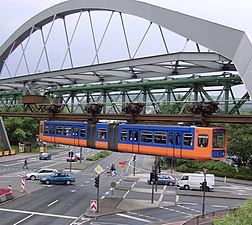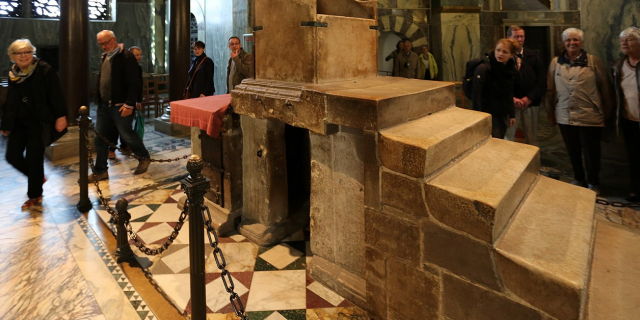Wuppertaler Schwebebahn
( Wuppertal Schwebebahn )
The Wuppertaler Schwebebahn (English: Wuppertal Suspension Railway) is a suspension railway in Wuppertal, Germany. The line was originally called the German: Einschienige Hängebahn System Eugen Langen (English: Eugen Langen Monorail Overhead Conveyor System) named for its inventor, Eugen Langen. It is the oldest electric elevated railway with hanging cars in the world and is a unique system in Germany.
Langen first offered the technology to the cities of Berlin, Munich, and Breslau who all turned it down. However, the towns of Barmen, Elberfeld, and Vohwinkel along the banks of the river Wupper were intrigued by the technology’s ability to connect their communities. The elevated tracks and stations were built between 1897 and 1903; the first track opened in 1901. The railway line is credited with growth of the original cities and their eventual merger into Wuppertal. The ...Read more
The Wuppertaler Schwebebahn (English: Wuppertal Suspension Railway) is a suspension railway in Wuppertal, Germany. The line was originally called the German: Einschienige Hängebahn System Eugen Langen (English: Eugen Langen Monorail Overhead Conveyor System) named for its inventor, Eugen Langen. It is the oldest electric elevated railway with hanging cars in the world and is a unique system in Germany.
Langen first offered the technology to the cities of Berlin, Munich, and Breslau who all turned it down. However, the towns of Barmen, Elberfeld, and Vohwinkel along the banks of the river Wupper were intrigued by the technology’s ability to connect their communities. The elevated tracks and stations were built between 1897 and 1903; the first track opened in 1901. The railway line is credited with growth of the original cities and their eventual merger into Wuppertal. The Schwebebahn is still in use as a local public transport line, moving 25 million passengers annually, per the 2008 annual report. New rail cars were ordered in 2015, called Generation 15, and the first new car went into service in December 2016.
The Schwebebahn runs along a route of 13.3 kilometres (8.3 mi), at a height of about 12 metres (39 ft) above the river Wupper between Oberbarmen and Sonnborner Straße (10 kilometres or 6.2 miles) and about 8 metres (26 ft) above the valley road between Sonnborner Straße and Vohwinkel (3.3 kilometres or 2.1 miles). At one point the railway crosses the A46 motorway. The entire trip takes about 30 minutes. The Schwebebahn operates within the Verkehrsverbund Rhein-Ruhr (VRR) and accepts tickets issued by the VRR companies including the Deutschlandticket.
The Wuppertaler Schwebebahn had a forerunner: in 1824, Henry Robinson Palmer of Britain presented a railway system which differed from all previous constructions. It was a low single-rail suspension railway on which the carriages were drawn by horses. Friedrich Harkort, a Prussian industrial entrepreneur and politician, loved the idea. He saw big advantages for the transportation of coal to the early industrialised region in and around the Wupper valley. Harkort had his own steel mill in Elberfeld; he built a demonstration segment of the Palmer system and set it up in 1826 on the grounds of what is today the Wuppertal tax office. He tried to attract public attention to his railway plans.
On 9 September 1826, the town councillors of Elberfeld met to discuss the use of a "Palmer's Railway" from the Ruhr region, Hinsbeck, or Langenberg, to the Wupper valley, Elberfeld, connecting Harkort's factories. Friedrich Harkort inspected the projected route with a surveyor and a member of the town council. The plans never went ahead because of protests from the transport branch[clarification needed] and owners of mills that were not on the routes.
In 1887 the cities of Elberfeld and Barmen formed a commission for the construction of an elevated railway or Hochbahn. In 1894 they chose the system of the engineer Eugen Langen of Cologne, and in 1896 the order was licensed by the City of Düsseldorf.[1][2] In 2003, the Rhine Heritage Office (Rheinisches Amt für Denkmalpflege des Landschaftsverbandes Rheinland or LVR) announced the discovery of an original section of the test route of the Schwebebahn.[citation needed]
Construction on the actual Schwebebahn began in 1898, overseen by the government's master builder, Wilhelm Feldmann. On 24 October 1900, Emperor Wilhelm II participated in a monorail trial run.[1]
In 1901 the railway came into operation. It opened in sections: the line from Kluse to Zoo/Stadion opened on 1 March, the line to the western terminus at Vohwinkel opened on 24 May, while the line to the eastern terminus at Oberbarmen did not open until 27 June 1903.[3] Around 19,200 tonnes (18,900 long tons; 21,200 short tons) of steel were used to produce the supporting frame and the stations.[1] The construction cost 16 million gold marks. The railway was closed owing to severe damage during World War II, but reopened as early as 1946.[3]






The Schwebebahn now carries approximately 80,000[4] passengers through the city per weekday. Since 1997, the supporting frame has been largely modernized, and many stations have been reconstructed and brought up to date technically. Kluse station, at the theatre in Elberfeld, was destroyed during the Second World War and was reconstructed during the modernization phase. Work was planned to be completed in 2001, but a serious accident took place in 1999 which left five people dead and 47 injured. That, along with delivery problems, delayed completion. By 2004, the cost of the reconstruction work had increased from €380 million to €480 million.[5]
On 15 December 2009, the Schwebebahn suspended its operations due to safety concerns. Several of the older support structures needed to be renewed, a process that was completed on 19 April 2010.[6]
In 2012, the Schwebebahn was closed for significant periods to allow upgrades to the system: from 7 to 21 July and 6 August to 22 October, and on weekends in September (15/16) and November (10/11).[7] The modernization was completed and the line fully reopened on 19 August 2013.
Post-2015 train replacementOn 10 November 2011, Wuppertaler Stadtwerke signed a contract with Vossloh Kiepe to supply a new fleet of Generation 15 or GTW 15 trains to gradually replace the ageing GTW 72 fleet. The 31 new articulated cars were assembled by Vossloh España in Valencia, Spain,[8] featuring a light blue livery and having cushioned seating, air conditioning, information displays, LED lights, improved disabled access, and induction motors with energy recovery during braking.[9] The first new train was commissioned by WSW in 2015[10][11] and entered regular passenger service on 18 December 2016,[12] at which point the line's power supply voltage was raised from 600 to 750 V.[13]
The GTW 72 stock was gradually withdrawn from service as the new trains were introduced, the last of which operated immediately prior to the line's shutdown in November 2018. WSW announced it would not scrap any of the GTW 72 stock, but instead offer 21 of the vehicles for sale and three for free, as long as they remained in the city of Wuppertal.[14][15]
In November 2018 a bus bar detached and fell to the ground but nobody was injured. Following this accident, the Schwebebahn was closed down for nearly nine months.[16] It re-opened on 1 August 2019.[17]
Sister suspension railway The Shonan Monorail, Japan, showing its sistership relationship with Wuppertaler Schwebebahn
The Shonan Monorail, Japan, showing its sistership relationship with Wuppertaler SchwebebahnWuppertal Schwebebahn has a sister suspension railway relationships with Shonan Monorail since 2018. Shonan Monorail is a suspension railway located in Kanagawa, Japan and connects the cities between Kamakura and Fujisawa. Both suspension railways made a campaign of its twinning.[18]
































Add new comment